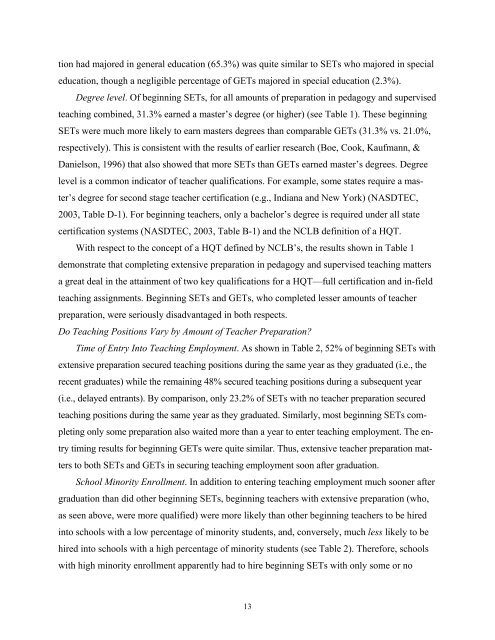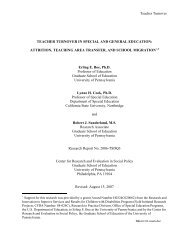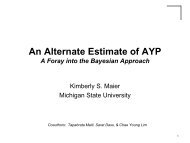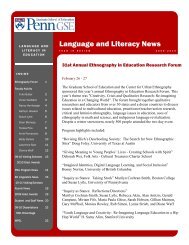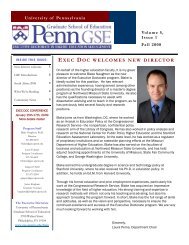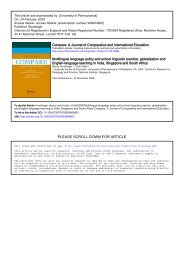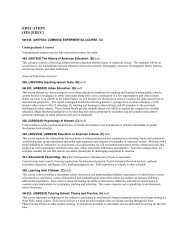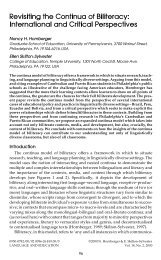does teacher preparation matter for beginning teachers in
does teacher preparation matter for beginning teachers in
does teacher preparation matter for beginning teachers in
Create successful ePaper yourself
Turn your PDF publications into a flip-book with our unique Google optimized e-Paper software.
tion had majored <strong>in</strong> general education (65.3%) was quite similar to SETs who majored <strong>in</strong> special<br />
education, though a negligible percentage of GETs majored <strong>in</strong> special education (2.3%).<br />
Degree level. Of <strong>beg<strong>in</strong>n<strong>in</strong>g</strong> SETs, <strong>for</strong> all amounts of <strong>preparation</strong> <strong>in</strong> pedagogy and supervised<br />
teach<strong>in</strong>g comb<strong>in</strong>ed, 31.3% earned a master’s degree (or higher) (see Table 1). These <strong>beg<strong>in</strong>n<strong>in</strong>g</strong><br />
SETs were much more likely to earn masters degrees than comparable GETs (31.3% vs. 21.0%,<br />
respectively). This is consistent with the results of earlier research (Boe, Cook, Kaufmann, &<br />
Danielson, 1996) that also showed that more SETs than GETs earned master’s degrees. Degree<br />
level is a common <strong>in</strong>dicator of <strong>teacher</strong> qualifications. For example, some states require a master’s<br />
degree <strong>for</strong> second stage <strong>teacher</strong> certification (e.g., Indiana and New York) (NASDTEC,<br />
2003, Table D-1). For <strong>beg<strong>in</strong>n<strong>in</strong>g</strong> <strong>teacher</strong>s, only a bachelor’s degree is required under all state<br />
certification systems (NASDTEC, 2003, Table B-1) and the NCLB def<strong>in</strong>ition of a HQT.<br />
With respect to the concept of a HQT def<strong>in</strong>ed by NCLB’s, the results shown <strong>in</strong> Table 1<br />
demonstrate that complet<strong>in</strong>g extensive <strong>preparation</strong> <strong>in</strong> pedagogy and supervised teach<strong>in</strong>g <strong>matter</strong>s<br />
a great deal <strong>in</strong> the atta<strong>in</strong>ment of two key qualifications <strong>for</strong> a HQT—full certification and <strong>in</strong>-field<br />
teach<strong>in</strong>g assignments. Beg<strong>in</strong>n<strong>in</strong>g SETs and GETs, who completed lesser amounts of <strong>teacher</strong><br />
<strong>preparation</strong>, were seriously disadvantaged <strong>in</strong> both respects.<br />
Do Teach<strong>in</strong>g Positions Vary by Amount of Teacher Preparation?<br />
Time of Entry Into Teach<strong>in</strong>g Employment. As shown <strong>in</strong> Table 2, 52% of <strong>beg<strong>in</strong>n<strong>in</strong>g</strong> SETs with<br />
extensive <strong>preparation</strong> secured teach<strong>in</strong>g positions dur<strong>in</strong>g the same year as they graduated (i.e., the<br />
recent graduates) while the rema<strong>in</strong><strong>in</strong>g 48% secured teach<strong>in</strong>g positions dur<strong>in</strong>g a subsequent year<br />
(i.e., delayed entrants). By comparison, only 23.2% of SETs with no <strong>teacher</strong> <strong>preparation</strong> secured<br />
teach<strong>in</strong>g positions dur<strong>in</strong>g the same year as they graduated. Similarly, most <strong>beg<strong>in</strong>n<strong>in</strong>g</strong> SETs complet<strong>in</strong>g<br />
only some <strong>preparation</strong> also waited more than a year to enter teach<strong>in</strong>g employment. The entry<br />
tim<strong>in</strong>g results <strong>for</strong> <strong>beg<strong>in</strong>n<strong>in</strong>g</strong> GETs were quite similar. Thus, extensive <strong>teacher</strong> <strong>preparation</strong> <strong>matter</strong>s<br />
to both SETs and GETs <strong>in</strong> secur<strong>in</strong>g teach<strong>in</strong>g employment soon after graduation.<br />
School M<strong>in</strong>ority Enrollment. In addition to enter<strong>in</strong>g teach<strong>in</strong>g employment much sooner after<br />
graduation than did other <strong>beg<strong>in</strong>n<strong>in</strong>g</strong> SETs, <strong>beg<strong>in</strong>n<strong>in</strong>g</strong> <strong>teacher</strong>s with extensive <strong>preparation</strong> (who,<br />
as seen above, were more qualified) were more likely than other <strong>beg<strong>in</strong>n<strong>in</strong>g</strong> <strong>teacher</strong>s to be hired<br />
<strong>in</strong>to schools with a low percentage of m<strong>in</strong>ority students, and, conversely, much less likely to be<br />
hired <strong>in</strong>to schools with a high percentage of m<strong>in</strong>ority students (see Table 2). There<strong>for</strong>e, schools<br />
with high m<strong>in</strong>ority enrollment apparently had to hire <strong>beg<strong>in</strong>n<strong>in</strong>g</strong> SETs with only some or no<br />
13


